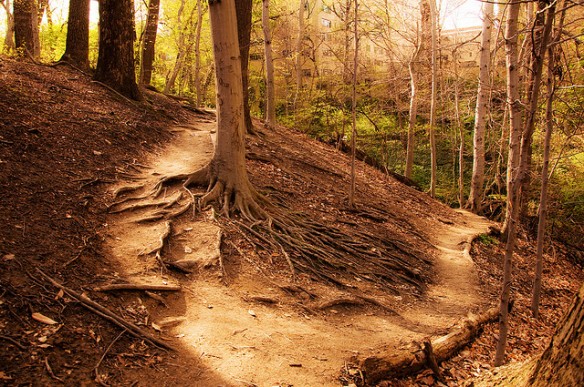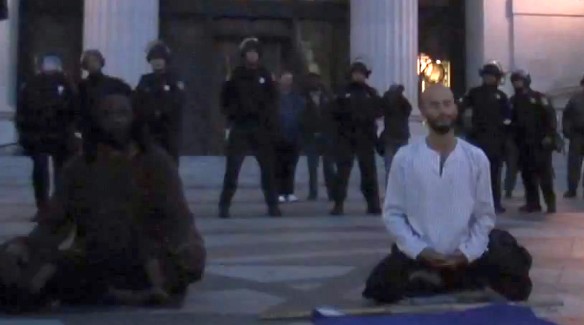In my previous post, I discussed the Buddhist principle of ‘not seeking,’ and how we are constantly involved in the act of seeking. I believe that over 99% of our waking hours are spent seeking, whether we are seeking after pleasures, comforts, and distractions, or seeking to avoid the opposite of those things. We are so used to seeking that we aren’t even aware when we are doing it. When we habituate our minds to certain tendencies, such as seeking, we act on those tendencies at an unconscious level. Therefore, seeking occurs at a very unconscious, imperceptible level in our minds.
The act of seeking, at this subtle level, is directly related to one of the twelve links in the Buddha’s teaching on dependent origination. The tenth link is called bhava in Sanskrit. In English, it is translated as becoming or continuation. The way in which seeking is related to this link is through its involvement in moving the mind’s attention away from the present and into the future. When we seek, we are always seeking after something in the future, because of the fact that in the present we feel discontent. Read More …
A couple months ago, during a conversation about DRBU planning, Professor Mark Mancall from Stanford University posed a question: “What does contemporary Buddhist architecture look like?” He said he’d been asking people this question lately whenever he has a conversation about Buddhism, and so far, he said, no one he’d talked to seemed confident that they had an answer.
… I can’t help but notice the interplay between the spaces that I spend my time in and my own attitudes and intentions.
I’ve never studied architecture formally, but I can’t help but notice the interplay between the spaces that I spend my time in and my own attitudes and intentions. In this sense I think there’s an opportunity for anyone to have some insight into how our environment affects our minds, and how our minds in turn affect the spaces that we create. We only need to pay attention.
For myself, lately I’ve been noticing where my thoughts tend to go in my cluttered bedroom. Opening the door is a regular reminder to tidy up my mental to-do list and clear out some of the nagging tasks that seem to pile up like old mail and laundry. In contrast I notice the ease of my walks around the monastery, watering plants every few days, soaking up a little bit of the easy-going harmony of nature. And of course I notice the Buddha hall, the calm and spacious complement to my otherwise hectic mind, where the careful attention invested by the community lends the space a relaxed and appreciative atmosphere — another good reminder to slow down and put that same kind of care into other aspects of my life. Read More …
[This is the fourth of a series of posts reflecting on how I found myself drawn to monasticism despite (or perhaps because of) my upbringing in the Bay Area and providing insight into how the relatively secular environment in which I grew up prompted me to look deeper into the meaning of life.]
As I was diving into the depths of the wisdom of the various religious traditions, I still had these burning questions in my heart: “What do I believe?” “What path am I supposed to follow?” And, I couldn’t help but feel torn. I found the Biblical teachings of Jesus extremely inspiring and skillful. Especially skillful, I thought, was the way he dealt with the Pharisees when they brought him an adulterer for judgment. They were testing him because Jewish law mandated death by stoning, which violated Roman law. He responded with the often-quoted words: “Let any one of you who is without sin be the first to throw a stone at her (John 8:7, NIV).” At this point, the Pharisees left one by one, leaving Jesus alone with the woman. He then told her that he didn’t condemn her and that she should mend her ways.
… it is, for me, a clear demonstration of the principles of forgiveness and compassion.
This story, like many others in the Bible, demonstrates the compassion and wisdom at the heart of the Christian tradition. It is also a source of debate among scholars, who have found that it is not contained in early manuscripts of the Bible. Regardless of its historicity, it is, for me, a clear demonstration of the principles of forgiveness and compassion. When I was reading the Bible, I had a sincere group of Christian friends who were quite honest with me about their lives and religious experiences and to whom I could definitely relate a lot more than than to the prevailing materialism of society. Read More …

… the flat tire represents mental structures that arise according to conditions from past karma, which influence how we perceive.
Imagine your car has a flat tire and the ride is very bumpy. Rather than stop and fix the flat, you keep driving. What could be a smooth ride with functional tires becomes very uncomfortable, but since you do not notice that the tire is flat, you keep your foot on the gas pedal! In ancient India, ease (sukha) conveyed the sense of a chariot running swiftly or easily (having a good axle-hole), whereas dis-ease (duḥkha) signified an uncomfortable chariot ride. In the analogy, the flat tire represents mental structures that arise according to conditions from past karma, which influence how we perceive. Just as in the case of the car, if we do not tune up our mind, we will have impairments to our ordinary experience. Like the bumpy ride, our cognitive and emotional apparatus will lead to a warped view of how we relate to the world around us. Read More …
Back in 2003, I first came across the original BTTS (Buddhist Text Translation Society) version of the Shurangama Sutra, which was available online. That sutra and its commentary had a profound effect on my view of the Dharma. In Master Hsuan Hua’s commentary, there were a few of his teachings that influenced me the most and that I became very attracted to. Two of them are part of his 6 Guiding Principles, which are upheld at the City of Ten Thousand Buddhas and recited everyday by the assembly.
The first is the principle of not seeking. The second is the principle of not pursuing personal advantage. The third is his teaching that we shouldn’t “climb on conditions.” To begin, I should explain what I am referring to when I use to term “seeking.” In the context of this post, seeking refers to a state of mind involved in trying to get something that one feels one’s presently lacking. First, one experiences a craving for something, and then one seeks after it. If one is involved in seeking, then that automatically implies that one’s mind is discontent. A mind that is completely content would have no reason to seek. Therefore, to practice not seeking is to cultivate inner contentment. In that way, practicing not seeking is a powerful way to counteract the first Noble Truth—dukkha or discontentment. Read More …
[This is the third of a series of posts reflecting on how I found myself drawn to monasticism despite (or perhaps because of) my upbringing in the Bay Area and providing insight into how the relatively secular environment in which I grew up prompted me to look deeper into the meaning of life.]
My mom’s look of confusion and unhappiness upon hearing about my monastic aspirations had its reasons. She would often tell me, “You are too idealistic! How are you going to support yourself?” And when I tried to explain to her that being a monastic was actually really practical, she would only get more upset. And yet was there any more lasting profession in history? Talk about job security! And what was even better was that no one else wanted to do it, so there was no competition.
Finding that my reasoning and arguments were of no use, I decided to keep quiet. But, in my heart, I strengthened my resolve to become a monastic. The rebellious, independent, self-righteous kid had decided what he wanted to do, and he was going to get his way. Stubbornness runs in my family. Read More …
The two men in this photo are Pancho Ramos Stierle and Adelaja Simon. I have meditated with them in the park near their home in Oakland where many homicides have taken place. We wanted to spread loving-kindness and help heal the wounds of something that is now very dysfunctional.
At the heart, there is the opportunity for change, even liberation. It just takes people who are willing to put in the work to wisely encourage the inherent goodness to prevail.
As for their personal practice, they have renounced many things. They meditate and practice yoga daily, work on developing urban gardens for the public, rarely use money, are celibate, refrain from speaking for one day a week, are vegetarian, refrain from eating refined sugar and processed foods, don’t have a cell phone, and last but not least, voluntarily live in a neighborhood plagued by danger—all in order to promote peace.
At the heart, there is the opportunity for change, even liberation. It just takes people who are willing to put in the work to wisely encourage the inherent goodness to prevail. We all make choices, and here are Pancho and Adelaja acting non-violently once again, in an area that is currently prone to discord. Read More …

On a beautiful Saturday last month, I went down to San Francisco’s Ocean beach to join a thousand other people in spelling out “TAX THE 1%” with our bodies in the sand, while a helicopter flew overhead and took pictures. Several local news stations ran stories on the demonstration, and everyone who was involved was later mailed a postcard of the aerial photo. In the picture above, I’m somewhere right in the middle of the second “T.”
Now I’m asking myself – why the fear of sincerity?
Occupying the beach when it’s 70 degrees and sunny – now that’s my kind of activism. I wrote that in the email I sent to my friends inviting them to come along, partly to be clear that this was going to be fun, not an act of martyrdom. But also, I’ll admit I was a bit self-conscious about seeming too earnestly engaged in what might have been seen as a very idealistic, ideological project, and making a joke was a way to maintain a little distance from the whole thing. Now I’m asking myself – why the fear of sincerity? Am I such a child of the Age of Irony that I’m compelled to be at least a little bit cynical about everything, all the time? Read More …
 SHARE
SHARE EMAIL
EMAIL COMMENT15 comments
COMMENT15 comments 







